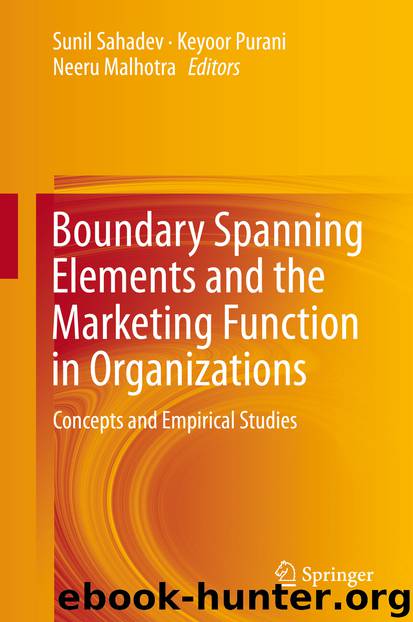Boundary Spanning Elements and the Marketing Function in Organizations by Sunil Sahadev Keyoor Purani & Neeru Malhotra

Author:Sunil Sahadev, Keyoor Purani & Neeru Malhotra
Language: eng
Format: epub
Publisher: Springer International Publishing, Cham
Goal Orientation and Role Conflict
Role conflict is defined as “the simultaneous occurrence of two (or more) sets of pressures such that compliance with one would make more difficult compliance with the other” (Kahn et al. 1964, p. 19). In any personal selling context sales persons frequently face conflicting demands both from the customer side as well as from the management through the sales supervisor. Such conflicting demand can lead to situations where it becomes very difficult to satisfy both the sides leading to role-conflict. In fact complying with either of the conflicting sets of demands could lead to short-term failure. However based on control theory, sales persons high in learning orientation have a long-term perspective and have a superordinate goal of mastering tasks that have a long-term orientation (Kohli et al. 1998; Harris et al. 2005). Salespersons who therefore have a learning orientation are not necessarily distracted from potential short-term failures. Moreover, learning orientation too often involves a focused mindset towards learning skills and improving abilities—a mentality that enables salespersons to be not excessively distracted by conflicting pressures.On the contrary as Sujan et al. (1994) contends, sales persons who have high performance orientation are focussed on short-term results. Excessive performance orientation could also lead to higher levels of self-awareness (Kanfer 1992). When the individual sales persons have high Self-awareness, he/she attaches greater importance to the individual’s performance appraisal without necessarily meeting customer needs. Such an orientation leads to situations where customer’s needs often conflicts with the priorities of the sales person (Harris et al. 2005) which leads to role-conflict. Thus, sales persons with higher levels of performance orientation will face greater role conflict and sales persons with higher learning orientation faces less levels of role conflict.
Download
This site does not store any files on its server. We only index and link to content provided by other sites. Please contact the content providers to delete copyright contents if any and email us, we'll remove relevant links or contents immediately.
Bullshit Jobs by David Graeber(3826)
Radical Candor by Kim Scott(2579)
I Am Right, You Are Wrong by Edward De Bono(2338)
23:27 by H. L. Roberts(2140)
Nomadland by Jessica Bruder(1955)
Average Is Over by Tyler Cowen(1754)
The Conflict Resolution Phrase Book by Barbara Mitchell & Cornelia Gamlem(1646)
Out of Our Minds: Learning to Be Creative by Ken Robinson(1625)
High-Impact Interview Questions by Victoria A. Hoevemeyer(1611)
The Ideal Team Player by Patrick M. Lencioni(1562)
An Everyone Culture: Becoming a Deliberately Developmental Organization by Robert Kegan & Lisa Laskow Lahey(1527)
The Asshole Survival Guide by Robert I. Sutton(1504)
Automatic Society by Bernard Stiegler(1462)
Unleashed by Anne Morriss & Frances Frei(1421)
Who by Street Randy & Smart Geoff(1418)
Who Moved My Cheese?: An Amazing Way to Deal With Change in Your Work and in Your Life by Johnson Spencer(1417)
42 Rules of Employee Engagement by Susan Stamm(1396)
96 Great Interview Questions to Ask Before You Hire by Paul Falcone(1354)
The Power of Disability by Al Etmanski(1286)
